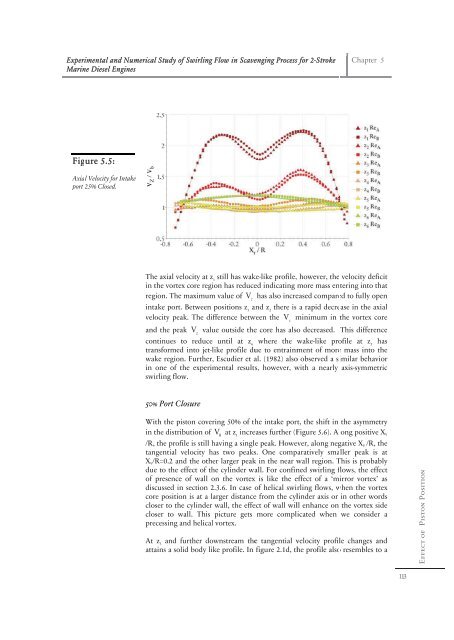Experimental and Numerical Study of Swirling ... - Solid Mechanics
Experimental and Numerical Study of Swirling ... - Solid Mechanics
Experimental and Numerical Study of Swirling ... - Solid Mechanics
You also want an ePaper? Increase the reach of your titles
YUMPU automatically turns print PDFs into web optimized ePapers that Google loves.
Experi imental <strong>and</strong> <strong>Numerical</strong> N Stud dy <strong>of</strong> <strong>Swirling</strong> g Flow in Scaveenging<br />
Processs<br />
for 2-Stroke<br />
Marin ne Diesel Engin nes<br />
Fig gure 5.5:<br />
Axial<br />
Velocity for Inta take<br />
port 25% 2 Closed.<br />
The axia al velocity at z still has wakke-like<br />
pr<strong>of</strong>ile, , however, thee<br />
velocity deficcit<br />
1<br />
in the vo ortex core region<br />
has reduceed<br />
indicating more mass enntering<br />
into that<br />
region. The T maximum m value <strong>of</strong> V has also increeased<br />
compareed<br />
to fully opeen<br />
z<br />
intake port. p Between positions z a<strong>and</strong><br />
z there is a rapid decreease<br />
in the axiial<br />
1 2<br />
velocity peak. The di ifference betwween<br />
the V mminimum<br />
in the vortex corre<br />
z<br />
<strong>and</strong> the peak V valu ue outside thee<br />
core has alsoo<br />
decreased. This differencce<br />
z<br />
continu ues to reduce e until at z where the wwake-like<br />
pro<strong>of</strong>ile<br />
at z has<br />
6<br />
5<br />
transfor rmed into jet- like pr<strong>of</strong>ile duue<br />
to entrainmment<br />
<strong>of</strong> moree<br />
mass into thhe<br />
wake re egion. Further r, Escudier et aal.<br />
(1982) alsoo<br />
observed a siimilar<br />
behavioor<br />
in one <strong>of</strong> the experimental<br />
resultts,<br />
however, wwith<br />
a nearly axis-symmetrric<br />
swirling g flow.<br />
50% Por rt Closure<br />
Chapter 5<br />
With th he piston covering<br />
50% <strong>of</strong> tthe<br />
intake porrt,<br />
the shift in the asymmetrry<br />
in the distribution<br />
<strong>of</strong> V at z increeases<br />
further (FFigure<br />
5.6). Allong<br />
positive XXv<br />
1<br />
/R, the pr<strong>of</strong>ile p is still having h a singlle<br />
peak. Howeever,<br />
along neggative<br />
Xv /R, thhe<br />
tangential<br />
velocity has h two peakss.<br />
One compparatively<br />
smaaller<br />
peak is at<br />
Xv/R=0.2 2 <strong>and</strong> the oth her larger peakk<br />
in the near wwall<br />
region. TThis<br />
is probabbly<br />
due to the t effect <strong>of</strong> th he cylinder wall.<br />
For confinned<br />
swirling fflows,<br />
the effect<br />
<strong>of</strong> prese ence <strong>of</strong> wall on o the vortexx<br />
is like the eeffect<br />
<strong>of</strong> a ‘mmirror<br />
vortex’ as<br />
discusse ed in section 2.3.6. 2 In case <strong>of</strong> helical swirling<br />
flows, wwhen<br />
the vorteex<br />
core pos sition is at a larger l distancee<br />
from the cyllinder<br />
axis or in other wordds<br />
closer to o the cylinder r wall, the effeect<br />
<strong>of</strong> wall willl<br />
enhance on the vortex sidde<br />
closer to t wall. This picture gets more complicated<br />
when we consider a<br />
precessing<br />
<strong>and</strong> helical l vortex.<br />
At z an nd further do ownstream thee<br />
tangential vvelocity<br />
pr<strong>of</strong>ille<br />
changes annd<br />
3<br />
attains a solid body li ike pr<strong>of</strong>ile. In figure 2.1d, thhe<br />
pr<strong>of</strong>ile alsoo<br />
resembles too<br />
a<br />
113<br />
Effect <strong>of</strong> Piston Position
















